key battery CHEVROLET BLAZER 1997 2.G Owners Manual
[x] Cancel search | Manufacturer: CHEVROLET, Model Year: 1997, Model line: BLAZER, Model: CHEVROLET BLAZER 1997 2.GPages: 402, PDF Size: 21.93 MB
Page 32 of 402
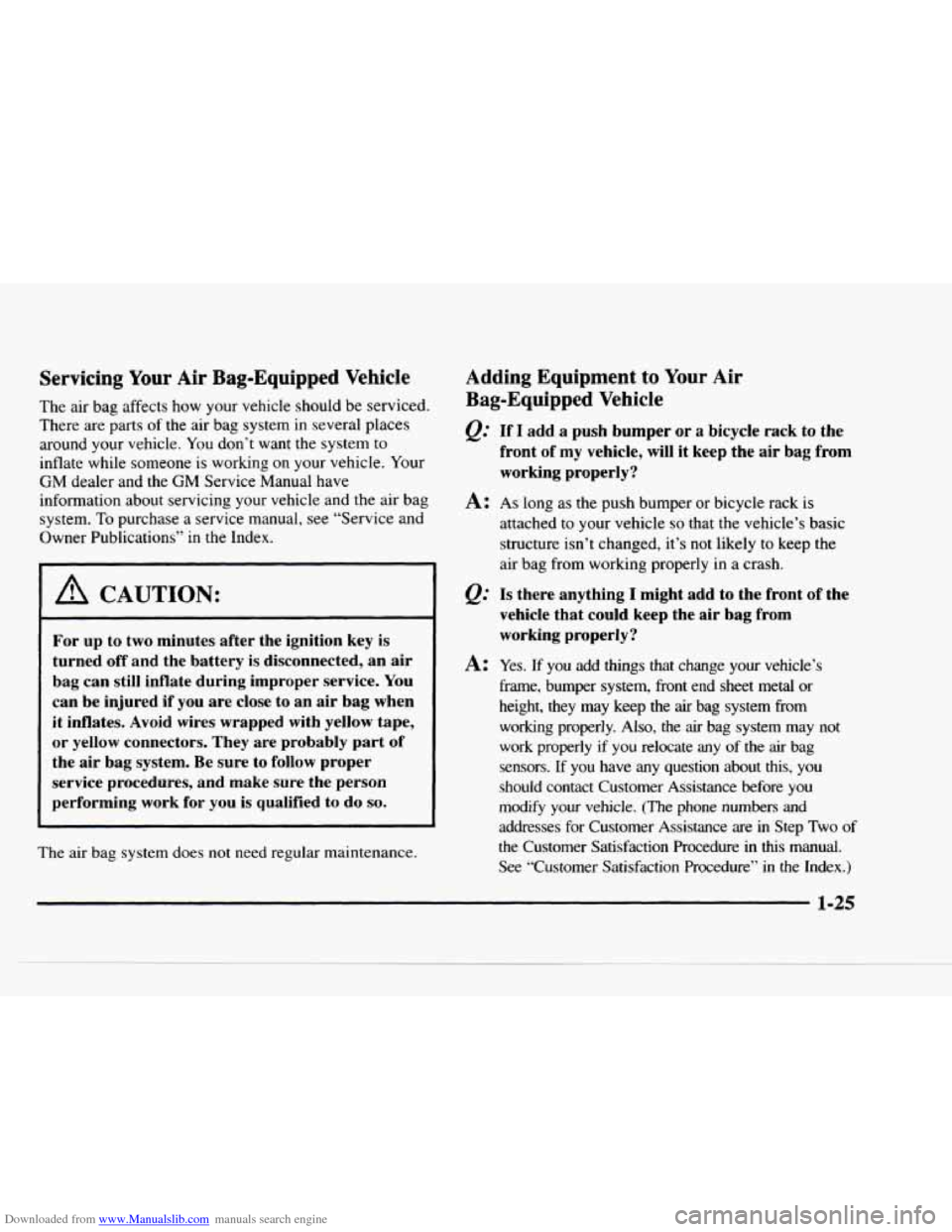
Downloaded from www.Manualslib.com manuals search engine Servicing Your Air Bag-Equipped Vehicle
The air bag affects how your vehicle should be serviced.
There are parts
of the air bag system in several places
around your vehicle. You don’t
want the system to
inflate while someone is working on your vehicle. Your
GM dealer and the GM Service Manual have
information about servicing your vehicle and the air bag
system. To purchase a service manual, see “Service and
Owner Publications” in the Index.
A CAUTION:
For up to two minutes after the ignition key is
turned off and the battery is disconnected, an air
bag can still inflate during improper service.
You
can be injured if you are close to an air bag when
it inflates. Avoid wires wrapped with yellow tape,
or yellow connectors. They are probably part
of
the air bag system. Be sure to follow proper
service procedures, and make sure the person
performing work for you
is qualified to do so.
~ ~ ~~~~ ~ ~
The air bag system does not need regular maintenance.
Adding Equipment to Your Air
Bag-Equipped Vehicle
Q: If I add a push bumper or a bicycle rack to the
front
of my vehicle, will it keep the air bag from
working properly?
A: As long as the push bumper or bicycle rack is
attached to your vehicle
so that the vehicle’s basic
structure isn’t changed, it’s not likely to keep the
air bag from working properly in a crash.
@’ Is there anything I might add to the front of the
vehicle that could keep the air
bap from
working properly?
A: Yes. If you add things that change your vehicle’s
frame, bumper system, front end sheet metal or
height, they may keep the
air bag system from
working properly. Also, the
air bag system may not
work properly
if you relocate any of the air bag
sensors.
If you have any question about this, you
should contact Customer Assistance before you
modify your vehicle. (The phone numbers
and
addresses for Customer Assistance are in Step Two of
the Customer Satisfaction Procedure in this manual.
See “Customer Satisfaction Procedure” in the Index.)
Page 63 of 402
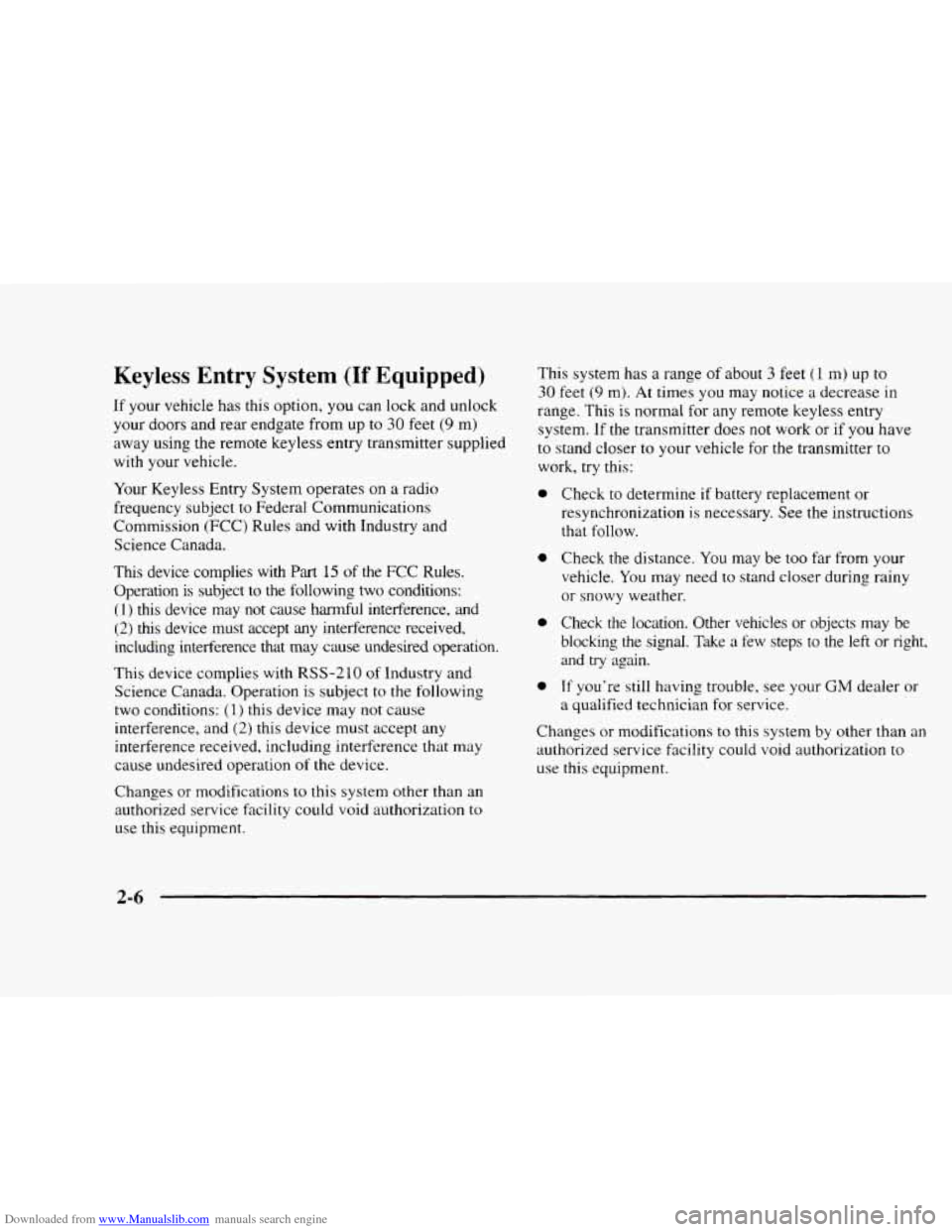
Downloaded from www.Manualslib.com manuals search engine Keyless Entry System (If Equipped)
If your vehicle has this option, you can lock and unlock
your doors and rear endgate from up
to 30 feet (9 m)
away using the remote keyless entry transmitter supplied
with your vehicle.
Your Keyless Entry System operates on
a radio
frequency subject to Federal Communications
Commission (FCC) Rules and with Industry and
Science Canada.
This device complies with
Part 15 of the FCC Rules.
Operation
is subject to the following two conditions:
(1 ) this device may not cause harmful interference, and
(2) this device must accept any interference received,
including interference that
may cause undesired operation.
This device complies with
RSS-210 of Industry and
Science Canada. Operation is subject
to the following
two conditions:
(1) this device may not cause
interference, and
(2) this device must accept any
interference received. including interference that may
cause undesired operation
of the device.
Changes or modifications to this system other than an
authorized service facility could void authorization
to
use this equipment. This
system has
a range of about 3 feet (1 m) up to
30 feet (9 m). At times you may notice a decrease in
range. This is normal for any remote keyless entry
system. If the transmitter does not work or if you have
to stand closer to your vehicle for the transmitter to
work, try this:
0
e
e
e
Check to determine if battery replacement or
resynchronization
is necessary. See the instructions
that follow.
Check the distance.
You may be too far from your
vehicle. You may
need to stand closer during rainy
or snowy weather.
Check the location. Other vehicles or objects may be
blocking the signal. Take
a few steps to the left or right,
and
try again.
If you're still having trouble. see your GM dealer or
a qualified technician for service.
Changes or modifications
to this system by other than an
authorized service facility could void authorization to
use this equipment.
2-6
Page 64 of 402
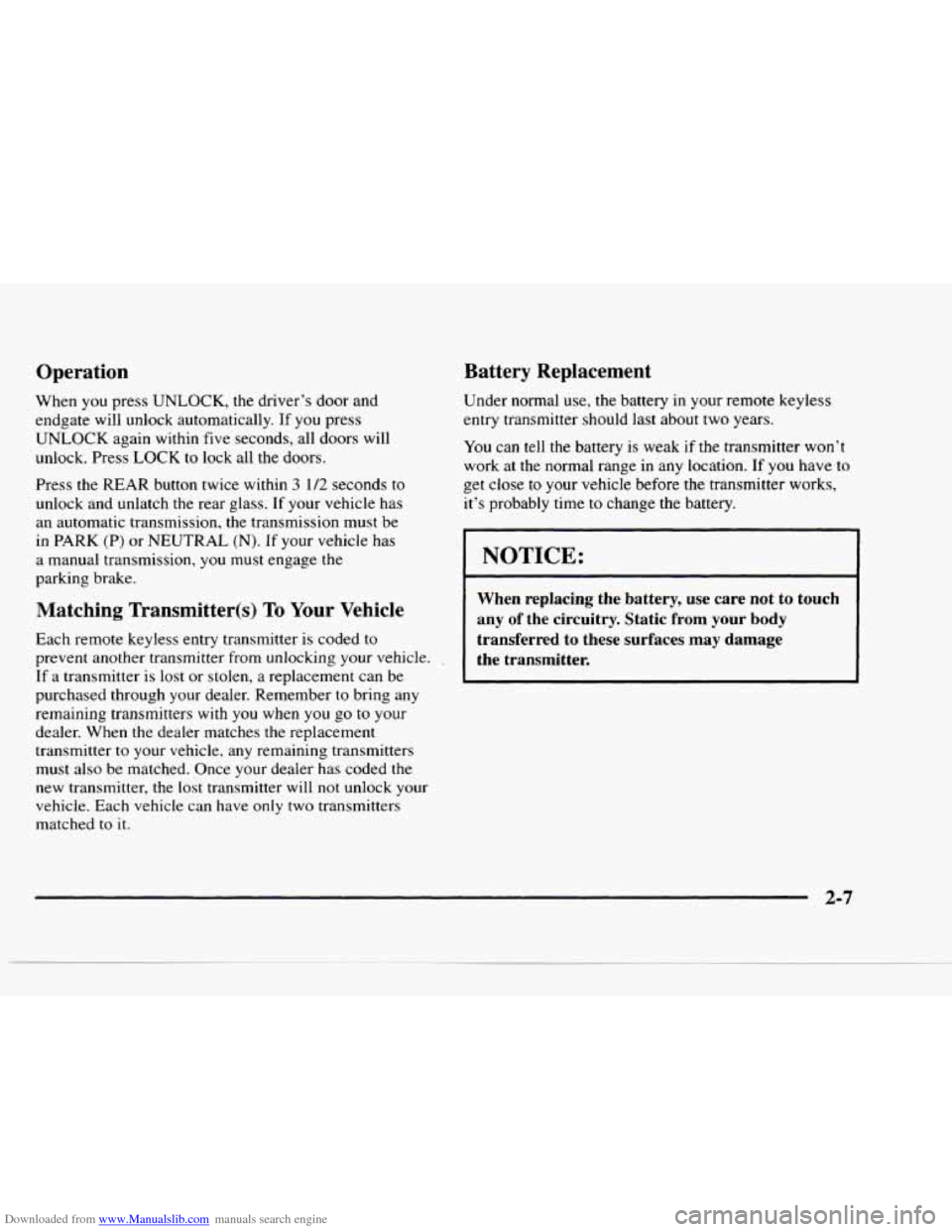
Downloaded from www.Manualslib.com manuals search engine Operation
When you press UNLOCK, the driver’s door and endgate will unlock automatically.
If you press
UNLOCK again within five seconds, all doors will
unlock. Press
LOCK to lock all the doors.
Battery Replacement
Under normal use, the battery in your remote keyless
entry transmitter should
last about two years.
Press the REAR button twice within
3 1/2 seconds to
unlock and unlatch
the rear glass. If your vehicle has
an automatic transmission, the transmission must be
in PARK (P) or NEUTRAL (N).
If your vehicle has
a manual transmission, you must engage the
parking brake.
Matching Transmitter(s) To Your Vehicle
Each remote keyless entry transmitter is coded to
prevent another transmitter from unlocking your vehicle.
If a transmitter is lost or stolen, a replacement can be
purchased through your dealer. Remember to bring any
remaining transmitters
with you when you go to your
dealer. When
the dealer matches the replacement
transmitter to your vehicle, any remaining transmitters
must also be matched. Once your dealer has coded the
new transmitter, the lost transmitter will not unlock your
vehicle. Each vehicle can have only two transmitters
matched
to it.
You can tell the battery is weak if the transmitter won’t
work at the normal range in any location.
If you have to
get close to your vehicle before the transmitter works,
it’s probably time to change the battery.
NOTICE:
When replacing the battery, use care not to touch
any of the circuitry. Static from your body
transferred to these surfaces may damage
the transmitter.
2-7
Page 65 of 402
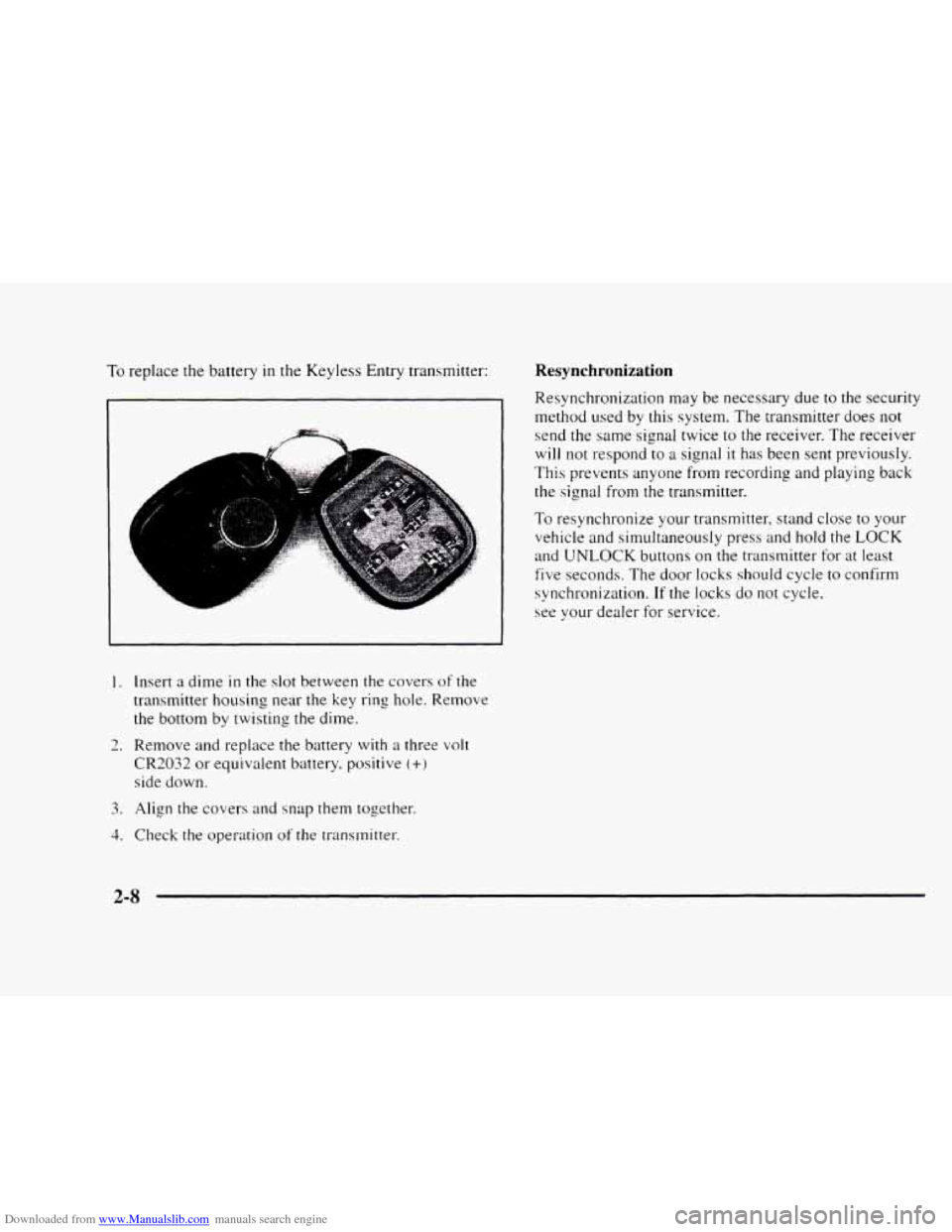
Downloaded from www.Manualslib.com manuals search engine To replace the battery in the Keyless Entry transmitter:
L
&.
I.
2.
3.
4.
Insert a dime in the slot between the covers of the
transmitter housing near the key ring hole. Remove
the bottom by twisting the dime.
Remove and replace the battery with
a three volt
CR2032 or equivalent battery, positive (+)
side down.
Align
the covers and snap them together.
Check the operation
of the transmitter.
Resynchronization
Resynchronization may be necessary due to the security
method used by this system. The transmitter does
not
send the same signal twice to the receiver. The receiver
will not respond to a signal it has been sent previously.
This prevents anyone from recording
and playing back
the signal from the transmitter.
To resynchronize your transmitter, stand close to your
vehicle and simultaneously press and hold the
LOCK
and UNLOCK buttons on the transmitter for at least
five seconds. The door locks should cycle to confirm
synchronization.
If the locks do not cycle,
see your dealer for service.
2-8
Page 71 of 402
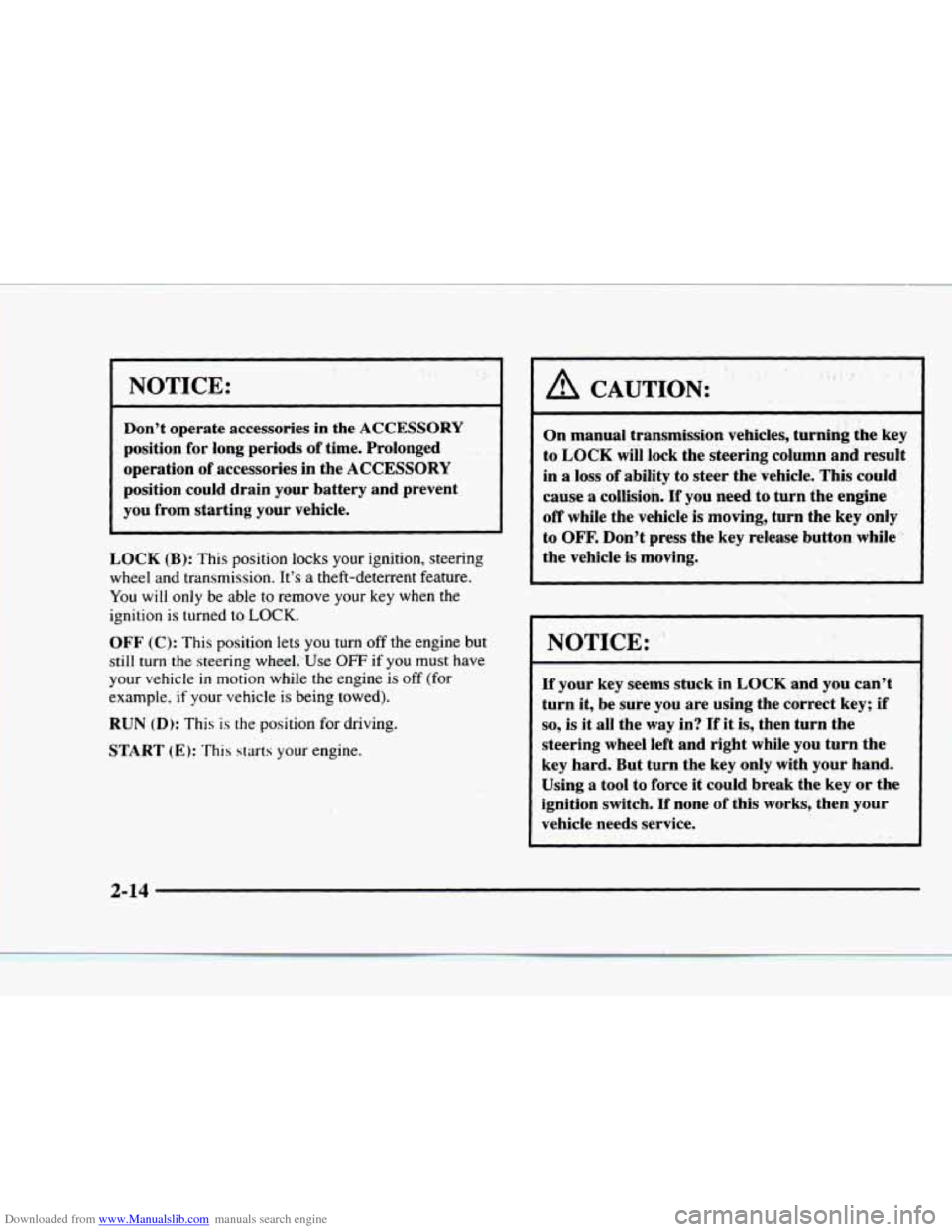
Downloaded from www.Manualslib.com manuals search engine NOTICE:
Don’t operate accessories in the ACCESSORY
position for long periods
of time. Prolonged
operation
of accessories in the ACCESSORY
position could drain your battery and prevent
you from starting your vehicle.
LOCK
(B): This position locks your ignition, steering
wheel and transmission. It’s
a theft-deterrent feature.
You will only be able to remove your key when the
ignition
is turned to LOCK.
OFF (C): This position lets you turn off the engine but
still turn the steering wheel. Use OFF if you must have
your vehicle
in motion while the engine is off (for
example,
if your vehicle is being towed).
RUN (D): This is the position for driving.
START (E): This starts your engine.
A CAUTION:
On manual transmission vehicles, turning the key
to LOCK will lock the steering column and result
in
a loss of ability to steer the vehicle. This could
cause a collision.
If you need to turn the engine
off while the vehicle is moving, turn the key only
to
OFF. Don’t press the key release button while
the vehicle
is moving.
_. .
NOTICE^^' Y!’> .‘sa !-
If your key seems stuck in LOCK and you can’t
turn it, be sure you are using the correct key; if
so, is it all the way in? If it is, then turn the
steering wheel left and right while you turn the
key hard. But turn the key only with your hand.
Using a tool to force
it could break the key or the
ignition switch.
If none of this works, then your
vehicle needs service.
2-14
Page 73 of 402
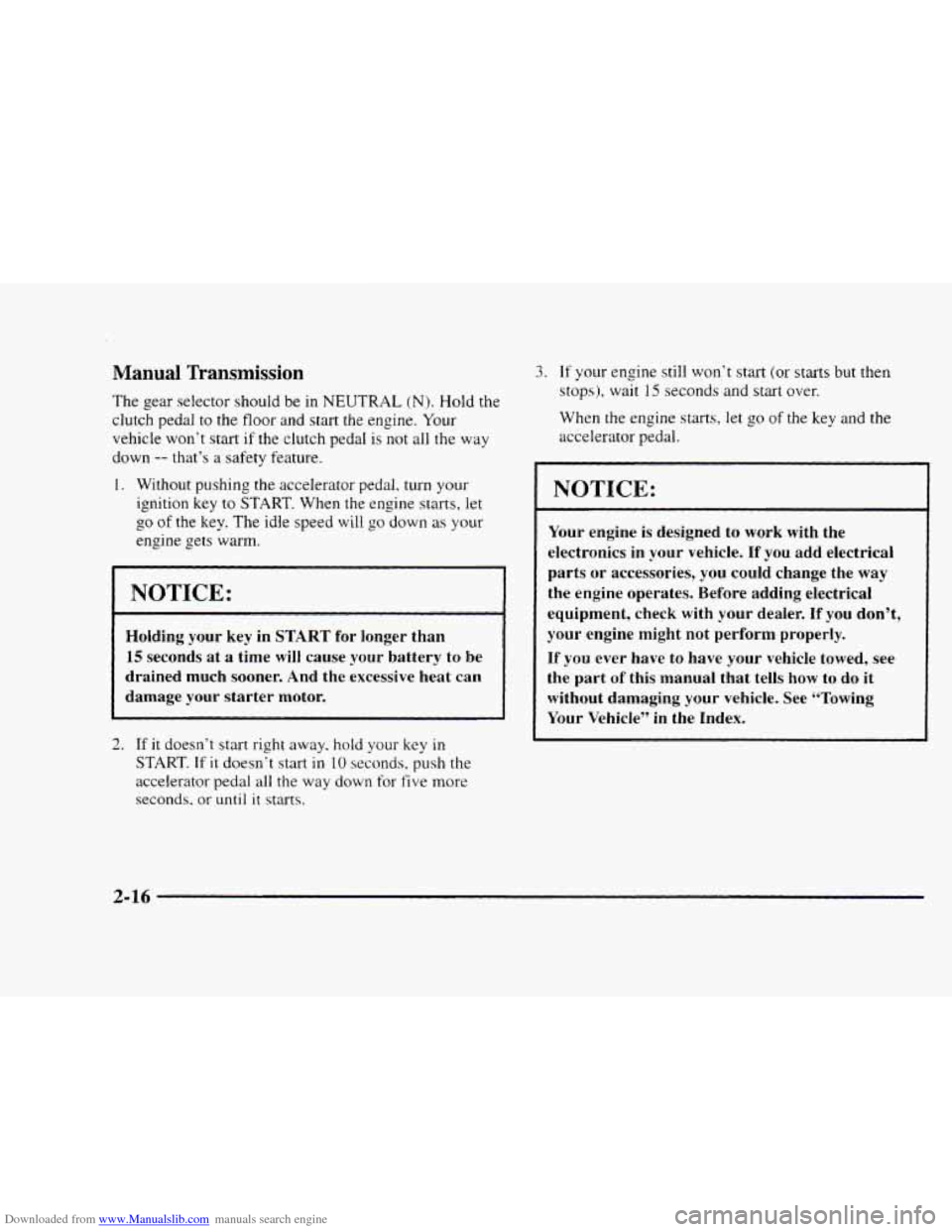
Downloaded from www.Manualslib.com manuals search engine Manual Transmission
The gear selector should be in NEUTRAL (N). Hold the
clutch pedal to the
floor and start the engine. Your
vehicle won’t start
if the clutch pedal is not all the way
down
-- that’s a safety feature.
1. Without pushing the accelerator pedal, turn your
ignition key to START. When the engine starts, let
go of the key. The idle speed will go down as your
engine gets warm.
NOTICE:
Holding your key in START for longer than
15 seconds at a time will cause your battery to be
drained much sooner.
And the excessive heat can
damage your starter motor.
2. If it doesn’t start right away, hold your key in
START. If it doesn‘t start in 10 seconds, push the
accelerator pedal
all the way down for five more
seconds. or
until it starts.
3. If your engine still won’t start (or starts but then
stops), wait
15 seconds and start over.
When the engine starts,
let go of the key and the
accelerator pedal.
NOTICE:
Your engine is designed to work with the
electronics in
your vehicle. If you add electrical
parts
or accessories, you could change the way
the engine operates. Before adding electrical
equipment, check with your dealer.
If you don’t.
your engine might not perform properly.
If you ever have to have your vehicle towed, see
the part
of this manual that tells how to do it
without damaging your vehicle. See “Towing
Your Vehicle” in the Index.
2-16
Page 75 of 402
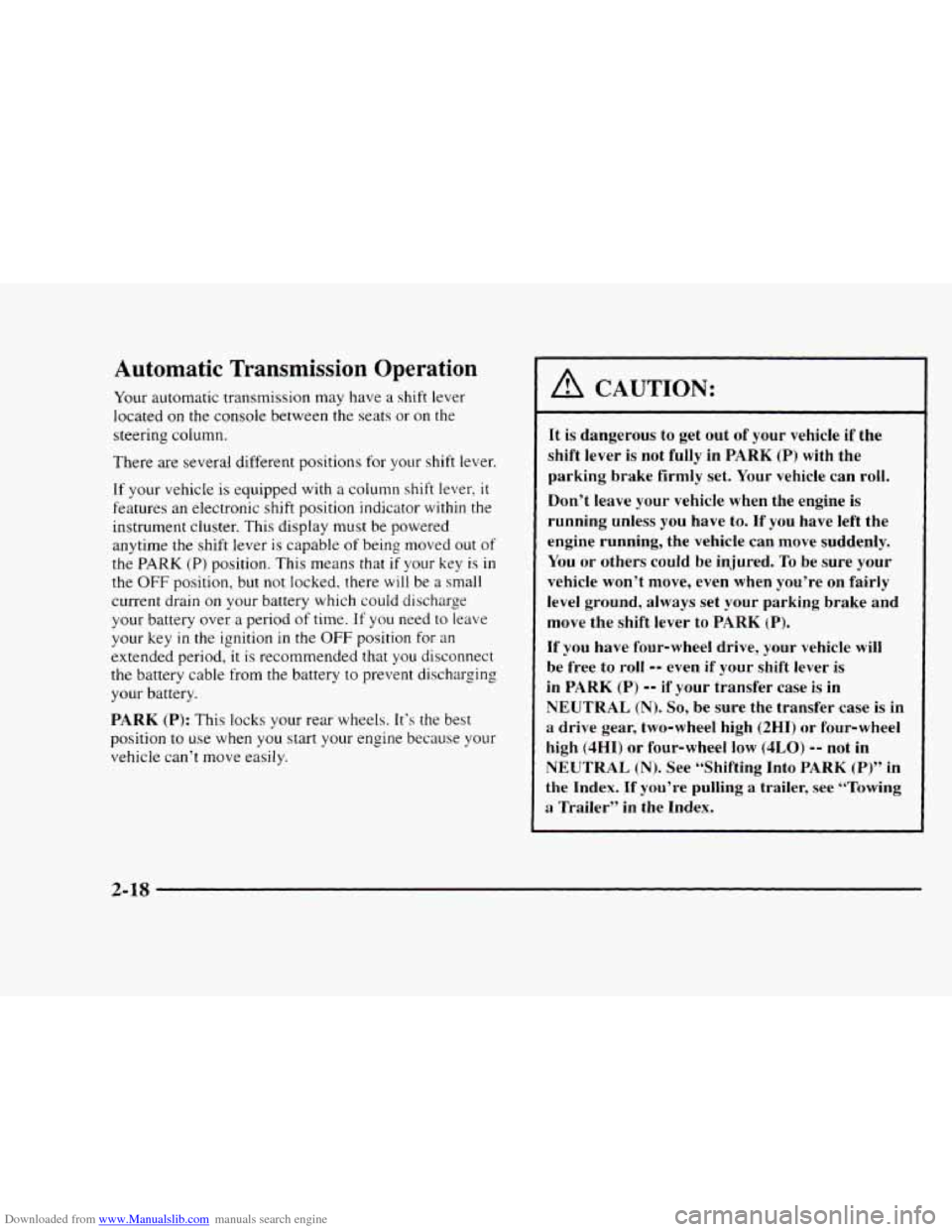
Downloaded from www.Manualslib.com manuals search engine Automatic Transmission Operation
Your automatic transmission may have a shift lever
located
on the console between the seats or on the
steering column.
There are several different positions
for your shift lever.
If your vehicle is equipped with a coiunm shift lever, it
features an electronic shift position indicator within the
instrument cluster. This display must be powered
anytime the shift lever is capable of being moved out of
the
PARK (P) position. This means that if your key is in
the
OFF position, but not locked, there will be a small
current drain
on your battery which could discharge
your battery over
a period of time. If you need to leave
your key
in the ignition in the OFF position for an
extended period, it is recommended that you disconnect
the battery cable from the battery to prevent discharging
your battery.
PARK (P): This locks your rear wheels. It’s the best
position to use when you start your engine because your
vehicle can‘t move easily.
A CAUTION:
It is dangerous to get out of your vehicle if the
shift lever
is not fully in PARK (P) with the
parking brake firmly set. Your vehicle can roll.
Don’t leave your vehicle when the engine
is
running unless you have to. If you have left the
engine running, the vehicle can move suddenly.
You or others
could be injured. To be sure your
vehicie won’t move, even when you’re on fairly
level ground, always set your parking brake and
move the shift lever to
PARK (P).
If you have four-wheel drive, your vehicle will
be free to
roll -- even if your shift lever is
in PARK (P) -- if your transfer case is in
NEUTRAL (N). So, be sure the transfer case is in
a drive gear, two-wheel high (2HI) or four-wheel
high (4HI) or four-wheel low (4LO) -- not in
NEUTRAL (Nj. See “Shifting Into PARK (P)” in
the Index.
If you’re pulling a trailer, see “Towing
a Trailer” in the Index.
2-18
Page 130 of 402
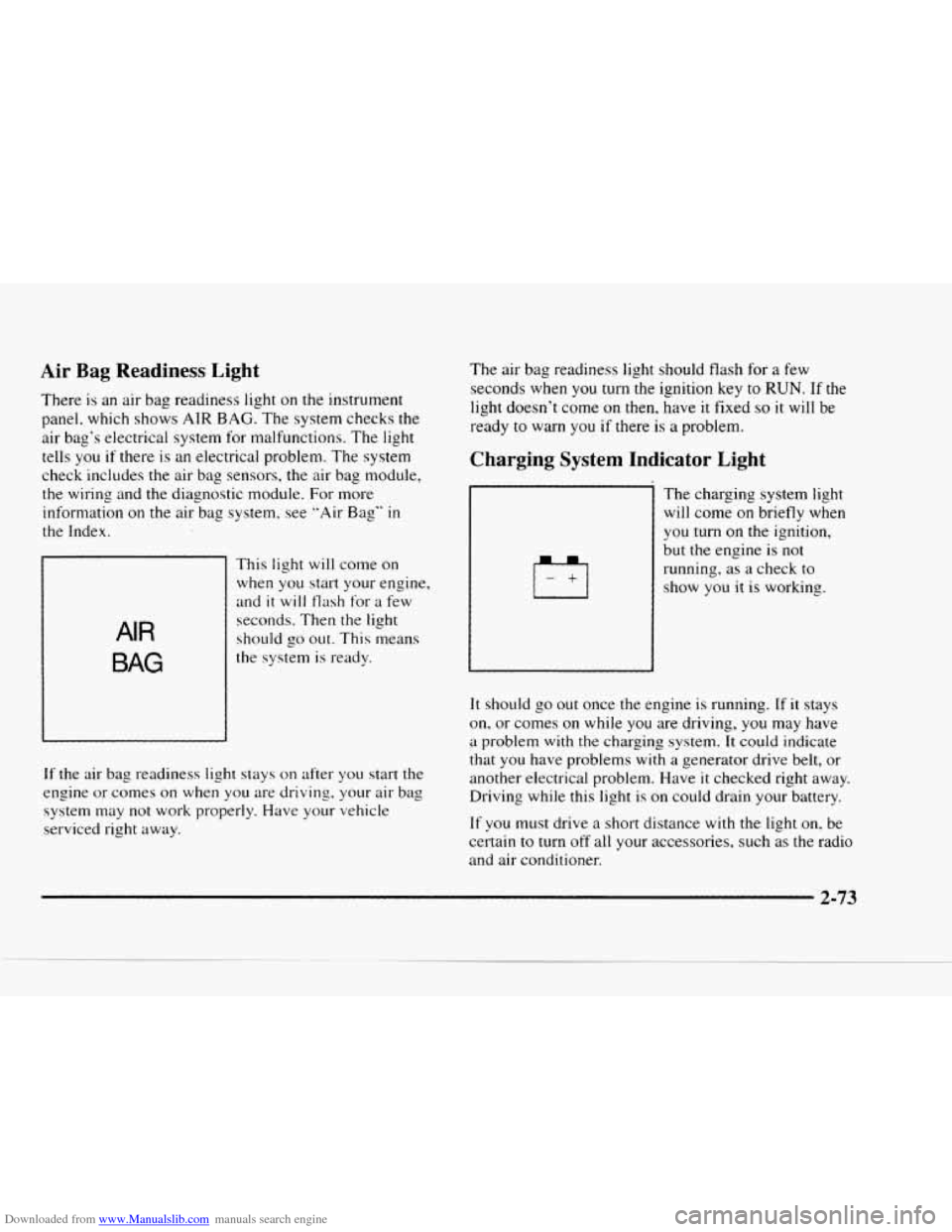
Downloaded from www.Manualslib.com manuals search engine Air Bag Readiness Light
There is an air bag readiness light on the instrument
panel, which shows
AIR BAG. The system checks the
air bag’s electrical system for malfunctions. The light
tells you
if there is an electrical problem. The system
check includes
the air bag sensors, the air bag module,
the wiring and
the diagnostic module. For more
information
on the air bag system, see ‘*Air Bag” in
the Index.
AIR
BAG
This light will come on
when you start your engine,
and
it will flash for a few
seconds.
Then the light
should
go out. This means
the system
is ready.
If the air bag readiness light stays on after you start the
engine or comes on when you are driving, your air bag
system may
not work properly. Have your vehicle
serviced right away. The
air bag
readiness light should flash for a few
seconds when
you turn the ignition key to RUN. If the
light doesn’t corne
on then, have it fixed so it will be
ready
to warn you if there is a problem.
Charging System Indicator Light
II..
~ The charging system light
~ will come on briefly when
you turn on the ignition,
but the engine is not
running,
as a check to
show you it is working.
It should go out once the engine is running. If it stays
on, or comes on while you are driving, you may have
a problem with the charging system. It could indicate
that
you have problems with a generator drive belt, or
another electrical problem. Have
it checked right away.
Driving while
this light is on could drain your battery.
If you must drive a short distance with the light on, be
certain to turn off all your accessories, such as the radio
and air conditioner.
2-73
Page 202 of 402
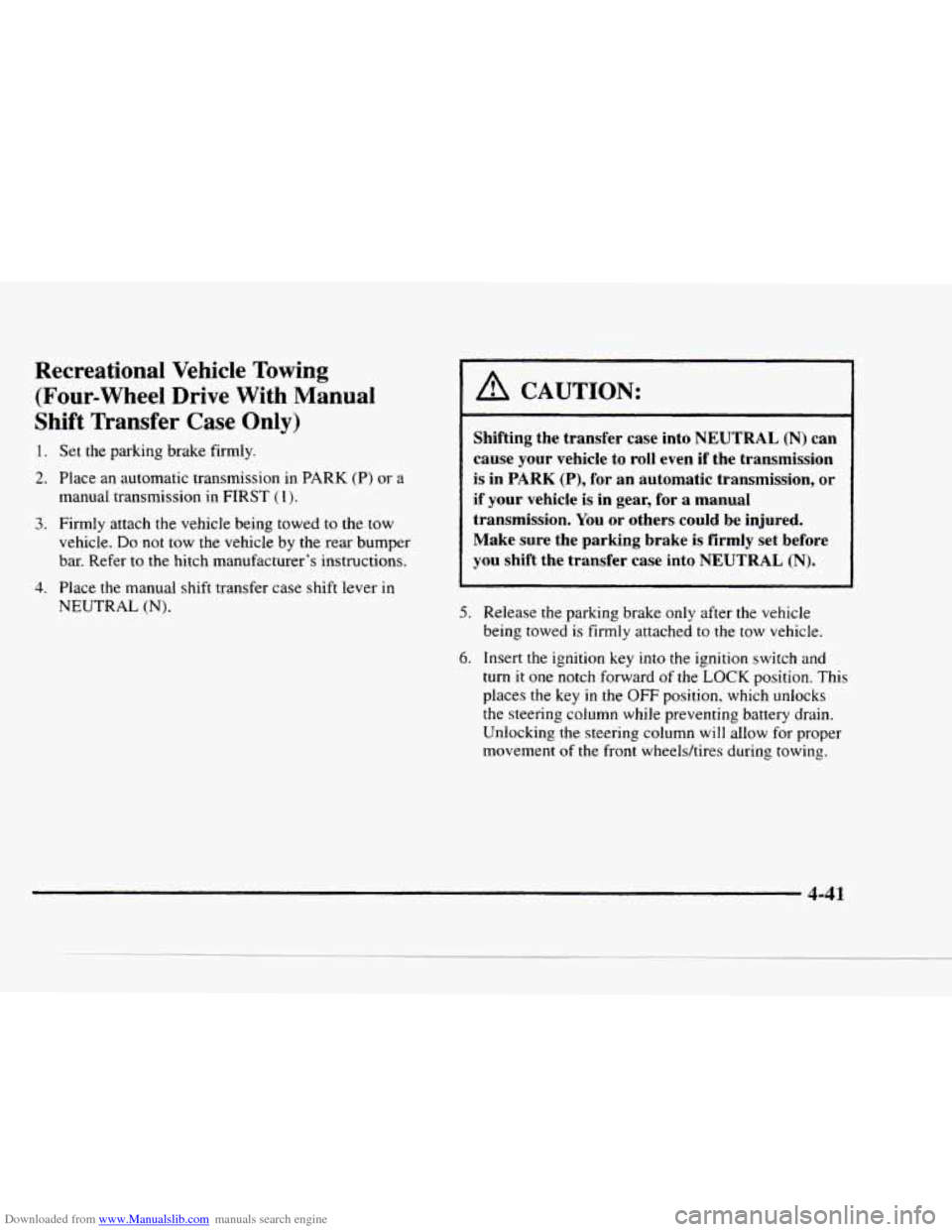
Downloaded from www.Manualslib.com manuals search engine Recreational Vehicle Towing (Four-wheel Drive With Manual
Shift Transfer
Case Only)
1. Set the parking brake firmly.
2. Place an automatic transmission in PARK (P) or a
manual transmission in FIRST ( 1 ).
3. Firmly attach the vehicle being towed to the tow
vehicle.
Do not tow the vehicle by the rear bumper
bar. Refer
to the hitch manufacturer’s instructions.
4. Place the manual shift transfer case shift lever in
NEUTRAL
(N).
I A CAUTION:
Shifting the transfer case into NEUTRAL (N) can
cause your vehicle to roll even if the transmission
is in PARK (P), for an automatic transmission, or
if your vehicle is in gear, for a manual
transmission.
You or others could be injured.
Make sure the parking brake
is firmly set before
you shift the transfer case into NEUTRAL
(N).
5. Release the parking brake only after the vehicle
being towed
is firmly attached to the tow vehicle.
6. Insert the ignition key into the ignition switch and
turn it
one notch forward of the LOCK position. This
places the key
in the OFF position, which unlocks
the steering column while preventing battery drain.
Unlocking the steering column
will allow for proper
movement
of the front wheelshires during towing.
4-41
Page 390 of 402
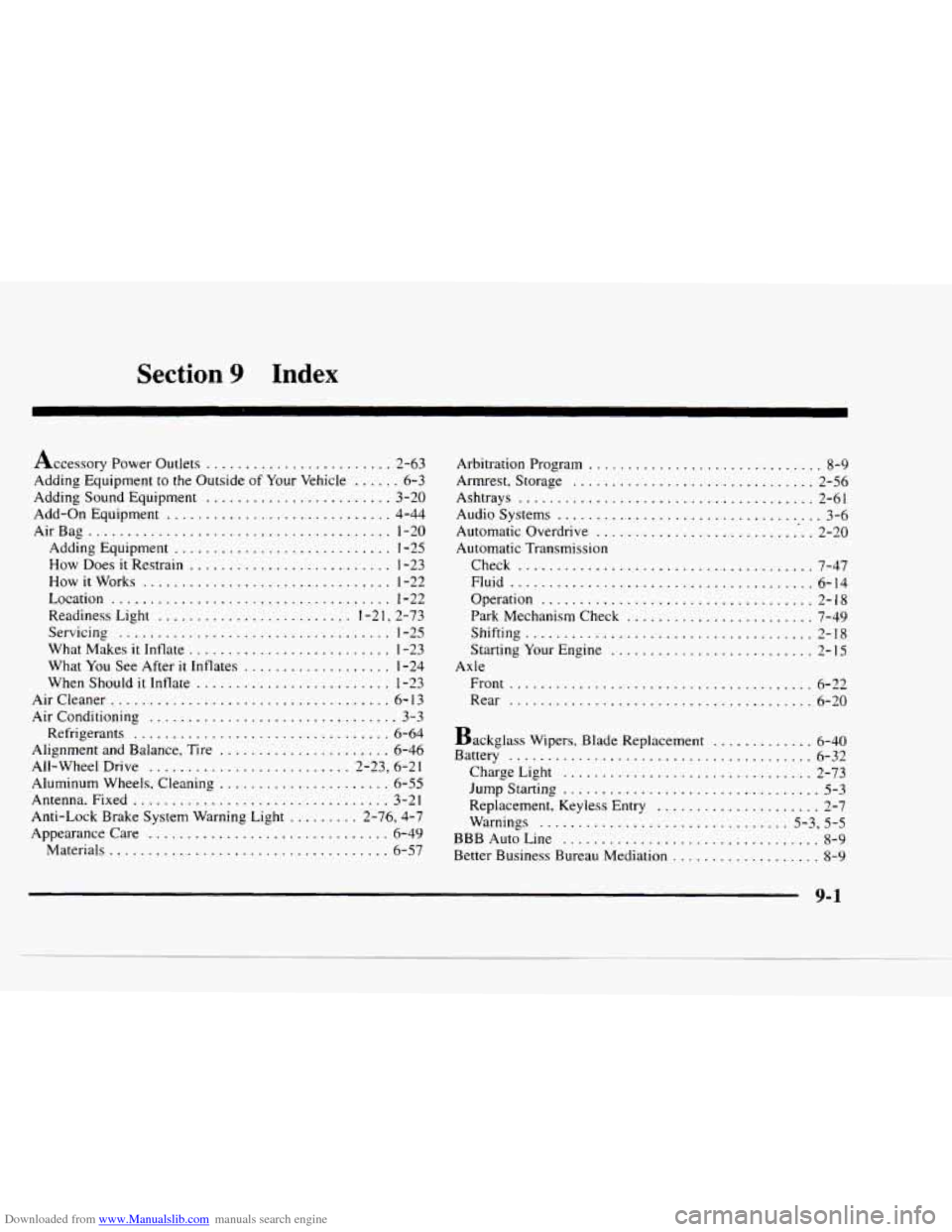
Downloaded from www.Manualslib.com manuals search engine Section 9 Index
Accessory Power Outlets ........................ 2-63
Adding Equipment to the Outside
of Your Vehicle ...... 6-3
Adding Sound Equipment
........................ 3-20
Add-on Equipment ............................. 4-44
AirBag
....................................... 1-20
Adding Equipment ............................ 1-25
How Does it Restrain .......................... 1-23
How it Works
................................ 1-22
Location
.................................... 1-22
Readiness Light
....................... . 1-21. 2-73
Servicing
................................... 1-25
What Makes it Intlate
.......................... 1-23
What
You See After it Inflates ................... 1-24
When Should
it Inflate ......................... 1-23
Aircleaner
.................................... 6-13
Air Conditioning
................................ 3-3
Refrigerants
................................. 6-64
Alignment and Balance, Tire ...................... 6-46
All-Wheel Drive
.......................... 2-23, 6-21
Aluminum Wheels. Cleaning
...................... 6-55
Antenna. Fixed
................................. 3-21
Appearancecare
............................... 6-49
Anti-Lock Brake
System Warning Light
......... 2-76, 4-7
Materials
.................................... 6-57 Arbitration Program
.............................. 8-9
Ashtrays ...................................... 2-61
Audio Systems
.................................. 3-6
Automatic Overdrive
............................ 2-20
Automatic Transmission Check
...................................... 7-47
Fluid
....................................... 6-14
Operation
................................... 2-18
Park Mechanism Check
........................ 7-49
Shifting
..................................... 2-18
Starting Your Engine
.......................... 2-15
Armrest. Storage
............................... 2-56
Axle Front
....................................... 6-22
Rear
....................................... 6-20
Backglass Wipers.
Blade Replacement ............. 6-40
Battery ....................................... 6-32
ChargeLight
................................ 2-73
Jump Starting
................................. 5-3
Replacement. Keyless Entry
..................... 2-7
Warnings
................................ 5-3. 5-5
BBB Auto Line
................................. 8-9
Better Business Bureau Mediation
................... 8-9
9-1